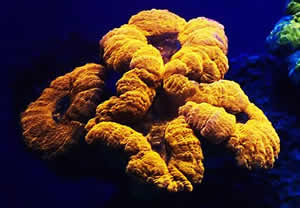
The fluorescence of this Lobophyllia coral can change from green to red when exposed to violet light. Credit Professor Jörg Wiedenmann
Glowing corals that display a surprising array of colors have been discovered in the deep water reefs of the Red Sea by scientists from the University of Southampton, UK, Tel Aviv University and the Interuniversity Institute for Marine Sciences (IUI), Israel, together with an international team of researchers.
The researchers, whose findings have been published online today in research journal PLOS ONE, hope that some of the coral pigments could be developed into new imaging tools for medical applications.
The team studied corals at depths of more than 50 meters and found that many of them glow brightly with fluorescent colors, ranging from green over yellow to red. The encounter of such a rainbow of coral colors in deep waters was unexpected, since their shallow-water counterparts in the same reef contain only green fluorescent pigments.
Jörg Wiedenmann, Professor of Biological Oceanography and Head of the University of Southampton's Coral Reef Laboratory, explains: "These fluorescent pigments are proteins. When they are illuminated with blue or ultraviolet light, they give back light of longer wavelengths, such as reds or greens.
"Their optical properties potentially make them important tools for biomedical imaging applications, as their fluorescent glow can be used to highlight living cells or cellular structures of interest under the microscope. They could also be applied to track cancer cells or as tools to screen for new drugs."
Gal Eyal, PhD candidate at the IUI, says: "Corals from these so-called mesophotic reefs are less well studied since they are beyond the depth limits of standard Scuba diving techniques. Advances in technical diving have enabled us to explore coral communities from these deeper waters.
"Since only the blue parts of the sunlight penetrate to depths greater than 50 meters, we were not expecting to see any red coloration around. To our surprise, we found a number of corals showing an intense green or orange glow. This could only be due to the presence of fluorescent pigments."
Such pigments are often found in shallow water corals, where they can act as sunscreens for the corals and their symbiotic algae. Finding them in depths where corals are struggling to collect enough light to sustain the photosynthesis of their algal symbionts (a vital energy source for the corals) is therefore unexpected.
Dr Cecilia D'Angelo, Senior Research Fellow at Southampton, has studied corals commonly found in mesophotic depths in the experimental aquarium of the University's Coral Reef Laboratory: "In many shallow water corals, the production of the pigments is tightly controlled by the amount and colour of the incidental light. In the majority of our deep water species, the pigment production is essentially independent from the light exposure of the coral animals.
"We found, however, that some of the pigments of these corals require violet light to switch from their nascent green color to the red hue of the mature pigment. This is a particularly interesting property to develop markers for advanced microscopic imaging applications."
The team now are now exploring which other biological functions these fluorescent pigments may fulfil.
Substantial parts of the research were conducted during the International Mesophotic Workshop 2014 held at the IUI in Eilat. Dr Yossi Loya, Professor of Zoology at Tel Aviv University and organizer of the workshop, concludes: "This study clearly shows the potential of interdisciplinary and international collaborations. We are delighted that the workshop has opened up such exiting new research avenues."
#
Full details of the research appear in: Spectral Diversity and Regulation of Coral Fluorescence in a Mesophotic Reef Habitat in the Red Sea Eyal G, Wiedenmann J, Grinblat M, D'Angelo C, Kramarsky-Winter E, Treibitz T, et al. (2015). PLOS ONE 10(6): e0128697. doi:10.1371/journal.pone.0128697
